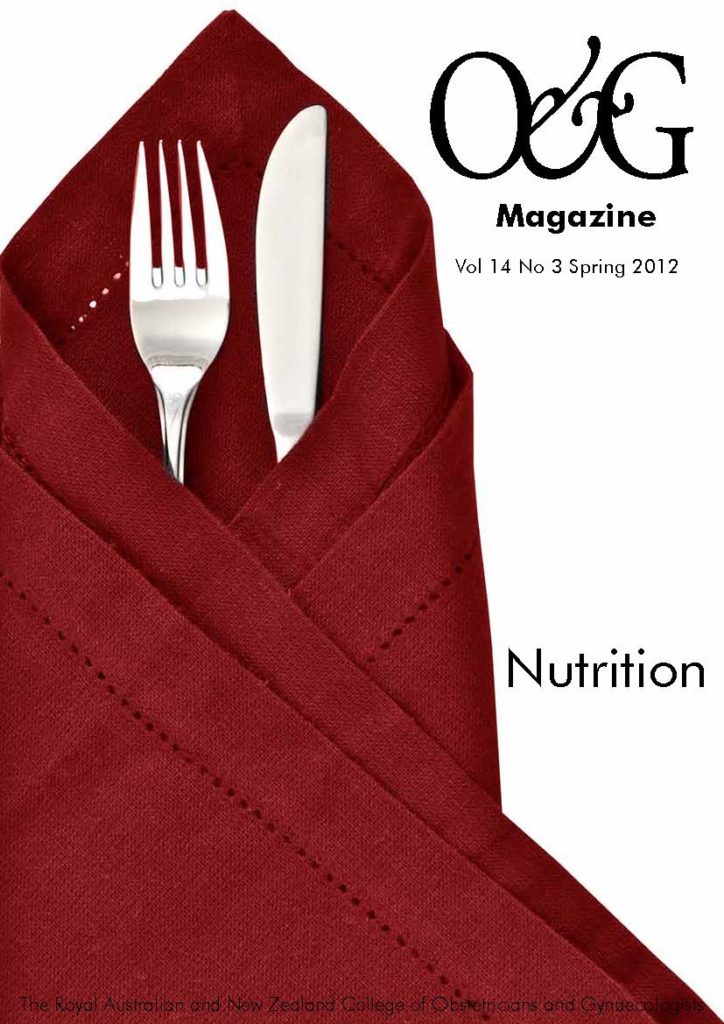Nutrition guidelines for a growing baby and a glowing mother.
As dietitians, we always hear stories from patients who are struggling to cut out ‘bad foods’, with negative connotations for their relationship with food, rather than making positive choices of foods that are delicious, to be enjoyed and shared. When people are encouraged to listen to their hunger and fullness signals and choose to eat what they want, enjoy and need, (guided by common sense) good nutrition often follows.
Pregnancy is no exception. The majority of women’s questions are about ‘danger foods’ and ‘foods to avoid’. The list often focuses on mercury-containing fish (with other, healthy, non-affected fish caught up ‘in the net’) and some, but not all, listeria-at-risk foods (usually some deli meats and soft cheese (see Box 1). While these are important issues – and if advice is not followed, it may have serious consequences – many dietitians are starting to suggest a refocus of priorities may be required.
The rate of listeriosis in Australia is miniscule compared with the high percentage of women not achieving healthy diet and lifestyle recommendations.1 Over 90 per cent of women do not meet fruit and vegetable guidelines for pregnancy2 and over 80 per cent consume excess amounts of ‘extra’ foods that are often high in saturated fats and sodium.3 Increasing numbers of women are starting pregnancy above a healthy body mass index (BMI) (30–50 per cent), often resulting in excessive gestational weight gain (50–100 per cent), depending on BMI range.2 These behaviours have serious outcomes during pregnancy and also contribute to lifelong risks for chronic disease.
Accuracy and completeness of pregnancy diet information is required and there are some simple strategies that can be followed to ensure food safety and hygiene to limit adverse reactions to foods. However, as women enter pregnancy with a range of dietary behaviours and beliefs, unfortunately not all of them healthy for themselves or their baby, we can draw on studies that have shown us how to deliver important messages to influence how likely it is that a woman will be able to incorporate this guidance into her lifestyle and food preferences. Encouragingly, women are interested in receiving antenatal nutrition education, information and support.2
What determines diet quality?
While the recommended number of serves from the groups outlined in Table 1 has recently been the focus of a large review process (to be finalised in late 2012) the final message will still be the same: meals and snacks should be based on fruit, vegetables/legumes and wholegrain breads/grains groups, with moderate amounts of dairy products and meats (or alternatives), and small amounts of healthy fats and oils. A balanced diet that meets the Australian Dietary Guidelines/Guide to Healthy Eating is recommended in pregnancy.
Food safety
- Fish consumption guidelines to reduce mercury consumption (http://www.foodstandards.gov.au/consumerinformation/mercuryinfish.cfm). Food Standards Australia New Zealand has set the following guidelines for safe fish intake in pregnancy.
| Pregnant women and women planning pregnancy (1 serve = 150 g) |
| 1 serve per fortnight of shark (flake) or billfish (swordfish/broadbill and marlin) and NO other fish that fortnight |
| OR |
| 1 serve per week of Orange Roughy (Deep Sea Perch) or catfish and NO other fish that week |
| OR |
| 2–3 serves per week of any other fish and seafood not listed above |
2. Minimising listeria at-risk foods (http://www.foodstandards.gov.au/consumerinformation/listeria/). It is easy to make safe choices by following these tips:
- Freshly prepared and cooked foods have low levels of bacteria. Bacteria grow over time, so avoid eating food if it has been made more than 24 hours since being prepared. Always reheat to steaming hot.
- Raw fruit and vegetables should be washed thoroughly before eating.
- Listeria is destroyed in normal cooking, so freshly cooked hot food is safe if eaten straight away
- Even at-risk foods risk can be eaten safely if heated above 74 degrees Celsius for over two minutes.
Foods that might carry listeria include:
- raw/uncooked/smoked meat and seafood, ready to eat chilled seafood;
- deli meats, cooked cold meat, pate, meat spreads;
- leftovers (more than 24 hours after cooking);
- pre-prepared salads, smorgasbords, buffets;
- unpasteurised milk and soft-serve ice cream;
- soft cheeses (brie, camembert, ricotta, feta, blue);
- unwashed raw fruit and vegetables; and
- raw eggs or foods containing raw or partially cooked eggs.
Hard cheeses, such as cheddar, are safe. Processed cheese, plain cream cheese and plain cottage cheese are fine if purchased sealed and stored in the fridge.
Table 1. Core food group serves for non-pregnant and pregnant women. (NHMRC, 2003)
| Women | Core food groups | |||||
| Cereals (including breads, rice, pasta and noodles) |
Vegetables and legumes |
Fruit | Milk, yoghurt, cheese |
Lean meat, fish, poultry, nuts and legumes |
Extra foods | |
| Aged 19–60 years (non-pregnant) |
4–9 | 5 | 2 | 2 | 1 | 0–2 |
| Pregnant women (all ages) |
4–6 | 5–6 | 4 | 2 | 1–1.5 | 0–2 |
Breads/cereals: 1 serve = 2 slices of bread, 1 medium bread roll, 1 cup cooked rice, pasta, noodles; vegetables/ legumes: 1 serve =1/2 cup (75g) cooked vegetables or legumes, 1 cup salad vegetables, 1 small potato; fruit: 1 serve = 1 medium, piece (150g) fruit, 1 cup diced pieces or canned fruit, ½ cup fruit juice; Milk: 1 serve = 1 cup (250ml) fresh milk, 2 slices (40g) cheese, 1 small carton (200g) yoghurt; Lean meat: 1 serve = 65- 100g cooked meat or chicken, 80–120g cooked fillet fish, 2 small eggs, 1/2 cup cooked legumes, 1/3 cup nuts, 1/2 cup sesames seeds; extras: foods that do not fit into the five food groups such as soft drink, crisps and chocolate.
Australian studies show women consume less than half the recommended levels of fruit and vegetables for pregnancy, impacting on a woman’s intake of folate, fibre and iodine – essential nutrients in pregnancy.2,4 Practitioners can start by simply asking a woman how many serves of fruit and vegetables she eats each day (see Table 1 for serve guides). Encourage her to increase her consumption towards her goal with simple, achievable changes. Fruit (fresh, tinned or dried) can be a great snack and frozen fruits are good for dessert. Soon to be released Pregnancy Lifescripts will also provide a useful guide to including these questions in a consult session.5
A woman’s gestational weight gain (GWG) goal depends on her pre-pregnancy weight. The Institute of Medicine6 (IOM) 2009 guidelines outlined in Table 2 are based on a systematic review of evidence that evaluated the optimal outcomes for both mother and baby. GWG outside these recommendations is associated with adverse outcomes during pregnancy, delivery and into the future beyond the immediate postpartum period. Women not advised of GWG guidelines are more likely to fall outside the recommended weight-gain range7 and following the 5As (assess, advise, assist, agree, arrange) framework outlined in a previous issue of O&G Magazine8 has had demonstrated reductions in overall GWG in a tertiary health service.9
Starting those ‘difficult conversations’
Recent research10 has highlighted confusion and uncertainty among maternity professionals regarding the most appropriate approach to take when counselling their patients about dietary quality and weight management. Concerns were also articulated about being effective, but not offensive, in the way clinicians convey information. The societal stigma associated with obesity has relevance for all health professionals striving to maintain good patient relationships, while providing evidence-based care.11 Terminology acceptable to patients may differ from that routinely used by health professionals; terms such as ‘weight’ and ‘BMI’ are likely to be received more positively than references to ‘fat’ and/or (morbidly) ‘obese’.12 When advising women about weight gain goals (informed by pre-pregnancy BMI), avoiding direct reference to BMI category names (such as ‘underweight’, ‘overweight’, ‘obese’ and so forth) and replacing with a more appropriate sentence, such as ‘based on your pre-pregnancy weight, you should aim to gain xx-xx kg for the healthiest pregnancy possible’ is more likely to (respectfully) promote healthy GWG.
Swap it, don’t stop it
Pregnancy is a time where some nutrient needs increase significantly, with only a small increase in energy needs, rendering the quality of the diet imperative. One of the most common traps people can fall in to is non-hungry eating (NHE). NHE is eating when you are not physically hungry for food. Some NHE is normal and many people do it. When we end up doing a lot of NHE it can be hard to achieve a balanced diet.13 We encourage women to achieve a balance between eating to appetite, meeting their food group requirements and tracking their weight gain. See Box 2 for more tips. Practical tips to help women implement these changes:
- Encourage women to make positive changes to meet their requirements for core foods.
- Pre-planning helps with positive choices – nutritious back-
up meals and snacks are cheap and quick substitutes for takeaway. Frozen pre-chopped vegetables, tinned soups with added beans, pasta with bottled sauces, or scrambled eggs with grated cheese and washed salad are quick-and-easy meal choices. - Start the conversation about dietary variety and recommended gestational weight gain.
- Monitor your patient’s weight following the 5As (assess, advise, assist, agree, arrange).7
- Encourage food safety (see Box 1), but encourage suitable omega-3-rich choices such as salmon and sardines. Vegetarian omega 3 sources include walnuts, canola oil and margarine, and linseed bread.
- Encourage women to seek expert dietary advice from an Accredited Practising Dietitian (APD). To access an APD in Australia, contact the Nutrition Department of your facility directly or go to: www.daa.asn.au and click on ‘Find an APD’, or call the toll-free APD hotline on 1800 812 942.
Tips for a more nutritious diet
If women are not gaining weight at the correct rate, recommend nutritious snacks. Good snacks include:
- fruit or grain toast with margarine, jams or nut spreads;
- dried fruit, nuts and seeds;
- yoghurt, custards and fromage frais;
- muesli bars, choose wholegrain with dried fruit and/or nuts;
- hard cheese and crackers; and
- milk drinks (Milo and milk, milkshakes, fruit smoothies).
If women are gaining weight too quickly, they need to make sure they are not ‘eating for two’. It is also important to include regular exercise most days. To help manage weight during pregnancy:
- choose fruit – fresh, tinned or frozen instead of higher calorie snacks;
- use minimal fat in cooking;
- choose low-fat milk, yogurt and cheese in place of full-fat products;
- trim all the fat off your meat before cooking and remove the skin from chicken;
- limit high-fat takeaway foods (or opt for salad alternatives);
- drink water and limit fruit juice to one serve a day;
- consider diet or low-joule products in place of sweetened soft drinks or cordial;
- limit intake of desserts and puddings; and
- minimise snacking on ‘extras’ outside of core food groups.
References
- Australian Bureau of Statistics. Australian Social Trends December 2010- one for the country: recent trends in fertility, 2010.
- Wilkinson SA, Tolcher D, (2010) Nutrition and maternal health: What women want and can we provide it? Nutrition & Dietetics, 67(1), 18-25.
- de Jersey SJ, Ross LJ, Himstedt K et al. For the Bambino Study group(2011) Weight gain and nutritional intake in obese pregnant women: Some clues for intervention. Nutrition & Dietetics, 68(1), 53-59.
- Wen LM, Flood VM, Simpson JM et al.(2011) Dietary behaviours during pregnancy: findings from first-time mothers in southwest Sydney,Australia. International Journal of Behavioral Nutrition and Physical Activity. 2010 Feb 3;7:13.
- Department of Health and Ageing. (2012) Pregnancy Lifescripts (underconstruction) http://www.health.gov.au/internet/main/publishing.nsf/Content/lifescripts-preg .
- Institute of Medicine (2009), National Research Council. Weight Gain During Pregnancy: Reexamining the Guidelines. National Academies Press: Washington, D.C.
- Tolcher D, Wilkinson SA. (2008). Beyond dieting – Innovative dietetic management of the obese pregnant woman. O&G Magazine, 10(4Summer), 19-20.
- Cogswell ME, Scanlon KS, Fein SB, Schieve LA. (1999). Medically advised mother’s personal target, and actual weight gain during pregnancy. Obstetrics & Gynecology, 94: 616-22.
- Wilkinson SA, Walker A, Tolcher D. Re-evaluation of women’s nutritional needs, knowledge, and behaviours in a tertiary maternity service: Are we meeting women’s needs yet? Nutrition & Dietetics (in press).
- Stotland N, Gilbert P, Bogetz A et al. (2010) Preventing excessive weight gain in pregnancy: How do prenatal care providers approach counseling? Journal of Women’s Health;19(4):807-14.
- Chisholm A, Hart J, Lam V, Peters S. (2011). Current challenges of behavior change talk for medical professionals and trainees. Patient Education and Counseling; doi:10.1016/j/pec.2011.12.001.
- Thomas S, Hyde J, Karunaratne A, Herbert D, Komesaroff P. (2008) Being ‘fat’ in today’s world: a qualitative study of the lived experiences of people with obesity in Australia. Health Expectations;11:321-30.
- Dr Rick Kausman www.ifnotdieting.com.au.







Leave a Reply